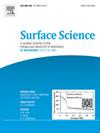掺杂过渡金属的HfS2单分子膜检测锂离子电池热失控气体的DFT研究
IF 1.8
4区 化学
Q3 CHEMISTRY, PHYSICAL
引用次数: 0
摘要
实时监测锂离子电池热失控过程中释放的特征气体(CO、CO2和C2H2)对电池安全至关重要。本文基于密度泛函理论,系统研究了掺杂过渡金属(Ag, Cu, Pt)的HfS2单层膜对热失控特征气体的吸附性能和气敏机理。通过对Cu-HfS2吸附能、电荷转移、态密度和能带结构等参数的分析,发现Cu-HfS2对CO的吸附性能最佳,且电荷转移显著。Ag-HfS2和Pt-HfS2对CO和C2H2也表现出较强的化学吸附性能。通过调节工作温度,可以实现对气体的选择性检测和快速解吸。结果表明,金属掺杂显著提高了HfS2的气敏性能,为开发高灵敏度、高选择性的锂离子电池热失控气体传感器提供了理论基础。本文章由计算机程序翻译,如有差异,请以英文原文为准。

DFT study of transition metal-doped HfS2 monolayers for detection of thermal runaway gases in lithium-ion batteries
Real-time monitoring of characteristic gases (CO, CO2, and C2H2) released during thermal runaway of lithium-ion batteries is crucial for battery safety. In this paper, the adsorption performance and gas-sensing mechanism of transition metal (Ag, Cu, Pt)-doped HfS2 monolayers for thermal runaway characteristic gases are systematically investigated based on density functional theory. By analyzing the parameters of adsorption energy, charge transfer, density of states and energy band structure, it is found that Cu-HfS2 exhibits optimal adsorption performance for CO with significant charge transfer. In addition, Ag-HfS2 and Pt-HfS2 also show strong chemisorption properties for CO and C2H2. The selective detection and rapid desorption of gases can be realized by modulating the working temperature. The results show that metal doping significantly improves the gas-sensing performance of HfS2, which provides a theoretical basis for the development of highly sensitive and selective lithium-ion battery thermal runaway gas sensors.
求助全文
通过发布文献求助,成功后即可免费获取论文全文。
去求助
来源期刊

Surface Science
化学-物理:凝聚态物理
CiteScore
3.30
自引率
5.30%
发文量
137
审稿时长
25 days
期刊介绍:
Surface Science is devoted to elucidating the fundamental aspects of chemistry and physics occurring at a wide range of surfaces and interfaces and to disseminating this knowledge fast. The journal welcomes a broad spectrum of topics, including but not limited to:
• model systems (e.g. in Ultra High Vacuum) under well-controlled reactive conditions
• nanoscale science and engineering, including manipulation of matter at the atomic/molecular scale and assembly phenomena
• reactivity of surfaces as related to various applied areas including heterogeneous catalysis, chemistry at electrified interfaces, and semiconductors functionalization
• phenomena at interfaces relevant to energy storage and conversion, and fuels production and utilization
• surface reactivity for environmental protection and pollution remediation
• interactions at surfaces of soft matter, including polymers and biomaterials.
Both experimental and theoretical work, including modeling, is within the scope of the journal. Work published in Surface Science reaches a wide readership, from chemistry and physics to biology and materials science and engineering, providing an excellent forum for cross-fertilization of ideas and broad dissemination of scientific discoveries.
 求助内容:
求助内容: 应助结果提醒方式:
应助结果提醒方式:


